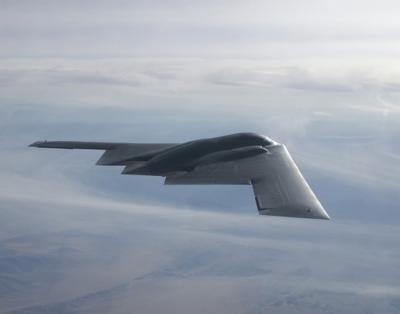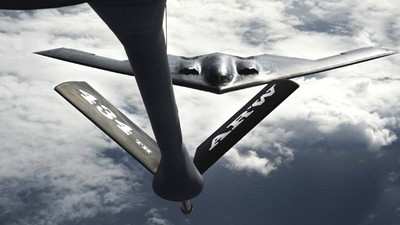Endurance Mission Ended With Inert Bombing Run At Edwards
AFB
Taking off from the flightline at Edwards Air Force Base October
27, a B-2 Spirit travelled to the top of the world and back again
on a mission to test the aircraft's hardware and software upgrades,
endurance and performance at extremely high latitudes. The more
than 18-hour mission to the North Pole and back to Edwards AFB
consisted of developmental and operational test points to prove
that the B-2's software upgrade works well and is able to operate
anywhere in the world.
USAF Photo

Although the B-2 has been to the North Pole in simulated tests,
this is the first time the aircraft has physically travelled there,
making this a milestone in B-2 testing. "A goal of the test force
is to prevent a situation where an aircraft experiences an anomaly
with a new system for the first time in an operational mission,"
said Lt. Col. Hans Miller, the 419th Flight Test Squadron
commander. "This flight to the North Pole could reveal data and
lessons that were not seen in a lab or simulated environment."
"This is the first time the B-2 has operated at this extreme of
a latitude before and (I believe) the longest flight so far for
this hardware and this software," said Maj. Michael Deaver, the
31st Test and Evaluation Squadron's B-2 Extremely High Frequency
Test director. "Being a global bomber, it may be required to
operate at extreme latitudes, if not where the target is, but
possibly for the flight path it'll take to get there."
The mission worked to verify that the software upgrades -- which
include new communication and new navigation equipment -- still
allows the B-2 to operate effectively anywhere in the world. "The
main objective of this mission is to look at how the software and
hardware works over a long duration (of time)," said 1st Lt. Derek
Moore, a 419th Flight Test Squadron test conductor. "We try to push
the limits of the aircraft and come back and make sure that
operationally it can still meet objectives."
The operational portion of this mission consisted of releasing
four unguided BDU-38 bombs over the Precision Impact Range Area at
Edwards AFB after more than 18 hours of flight. According to
Deaver, one of the biggest objectives was to make sure that the
aircraft knew where it was and that it could get to a weapons
release point. To get to that point, extensive coordination
throughout the 419th FLTS, Bomber Combined Task Force and other
Edwards AFB assets, as well as outside support including the
Department of State, was necessary for a successful mission.
"Support from the Air Force Flight Test Center allowed us to use
the Speckled Trout (412th Flight Test Squadron) as a resource,
which served as an airborne control room and communication hub,"
said Jeremiah Farinella, a 419th FLTS test conductor and operations
engineer. "That allowed us to troubleshoot some issues that we saw
when we were airborne and provided us communication back to
Edwards, which was essential to our success and allowed the pilots
to stay focused on the mission."
USAF Photo

Fairchild Air Force Base, WA, provided a KC-135 tanker aircraft
for aerial refueling support. The tanker refueled the B-2 over
Alberta, Canada, to ensure that the B-2 could complete the
endurance portion of the mission to the North Pole and then back to
Edwards, said Farinella. The B-2 was further supported with fuel
from a second KC-135 from Edwards AFB in the R-2508 Isabella Aerial
Refueling Track, which helped ensure that the B-2 could complete
the operational portion of the Polar mission. "We had an incredible
team that went with us, lessened our workload greatly, and
contributed to the fact that we were able to get up there and back
safely," said Maj. Andrew Murphy, a 419th FLTS B-2 experimental
test pilot. "(The team) really lowered the risk of the mission for
us."
 ANN's Daily Aero-Linx (12.03.25)
ANN's Daily Aero-Linx (12.03.25) ANN's Daily Aero-Term (12.03.25): CrewMember (UAS)
ANN's Daily Aero-Term (12.03.25): CrewMember (UAS) NTSB Prelim: Maule M-7-235A
NTSB Prelim: Maule M-7-235A Airborne-Flight Training 12.04.25: Ldg Fee Danger, Av Mental Health, PC-7 MKX
Airborne-Flight Training 12.04.25: Ldg Fee Danger, Av Mental Health, PC-7 MKX Aero-News: Quote of the Day (12.04.25)
Aero-News: Quote of the Day (12.04.25)




